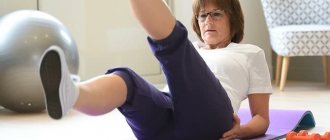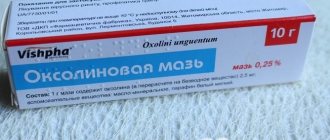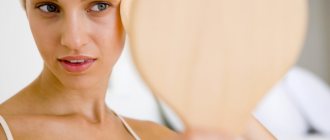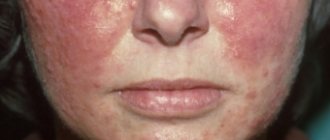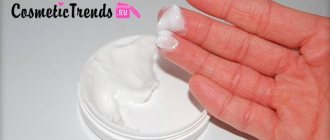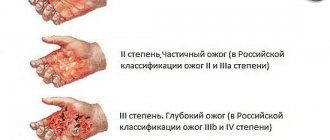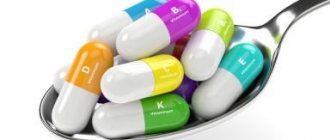Ointment for healing wounds and cracks
Ointments for wound healing are needed for skin damage due to trauma, burns, surgery, ulcers due to poor circulation, and bedsores. There are cheap and effective drugs - Levosin, Dexpanthenol, calendula ointment. With a small wound, they can be used independently, but with an increase in body temperature and purulent discharge, treatment must be prescribed by a doctor.
The following factors can influence how quickly a wound heals:
- Poor supply of blood and oxygen to the tissues adjacent to the wound. The more oxygen in the tissues, the faster the condition of the epithelium normalizes and the production of collagen accelerates.
- Body weight, age and diet. Proteins, minerals, vitamins, and carbohydrates are required in sufficient quantities. In older people with high body weight, wounds heal much more slowly.
- Pathogenic microbes. If a person has poor immunity, the wound is too dirty, and there are dead tissues, fragments, etc. left in it, then the production of repair fibers deteriorates. Microbes absorb oxygen, which is so necessary for body tissues.
- Diabetes.
- Taking certain medications (glucocorticoids, immunosuppressants). Vascular restoration and collagen production are inhibited, and local immunity is worse.
Healing of wounds and cracks occurs faster with the help of ointments with vitamin A - Videstim, vitamin complex (A, E, D) - Radevit asset, essential oils - Rescue balm.
We see
The drug Videstim is an ointment that accelerates skin recovery after:
- wounds and abrasions;
- superficial or deep cuts;
- cracks in the skin, nipples;
- dryness, inflammation;
- chapping;
- treatment with hormonal ointments and creams.
Contraindicated in case of vitamin A intolerance, suppuration. Apply twice a day - in the morning and before bed. It is recommended to treat the wound or crack with an antiseptic solution (for example, Chlorhexidine) before using it. The course of treatment continues until complete healing and can last from 1 to 3 months. Cannot be combined with tetracycline and vitamin A taken orally.
Radevit Active
The ointment contains a complex of fat-soluble vitamins – A, D, E, and has the following actions:
- restores skin integrity;
- increases the protective functions of the outer layer;
- relieves itching and inflammation;
- softens, increases moisture and elasticity;
- eliminates peeling.
The drug is indicated for cracks, erosions, ulcers, wounds (non-infected), burns, inflammation, severe dryness. It is often prescribed for recovery after cosmetic procedures, radiation, and operations. Apply a thin layer twice a day. In case of acute inflammation and allergies, it may increase redness and swelling. During pregnancy and lactation, extensive lubrication of the skin is not recommended.
Balm Rescuer
This product contains beeswax, milk fats, tea tree and lavender essential oils, echinacea, vitamin E. The balm has a wound healing and anti-inflammatory effect, as well as:
- destroys bacteria;
- moisturizes;
- relieves pain;
- nourishes and softens the skin;
- protects against overdrying and dehydration;
- stimulates blood circulation;
- eliminates irritation.
Balm Rescuer is used for:
- skin cracks;
- shallow wounds;
- sprains;
- injuries;
- burns;
- bruises;
- acne;
- inflammatory processes.
It is applied to the skin under a bandage, but when changing, it is recommended to take a break when the wound should dry out a little - 15-20 minutes. The components of the balm can cause redness, itching, and burning. The drug should not be used for chronic ulcerative skin defects. Allowed for children and pregnant women. It cannot be combined with lubrication with iodine and hydrogen peroxide.
To regenerate the skin of a child, you can use ointments Baneocin, Videstim, Rescuer. Very effective and safe products are Bepanten and Sudocrem. They are allowed from birth. Bepanten plus has an additional antibacterial effect; it can be used to treat children after one year of age.
Bepanten
The drug is indicated for healing wounds, scratches, abrasions and minor burns. In infants, it is used under a diaper to prevent skin irritation. For children, it is applied to the damaged area 1-3 times a day. Adverse reactions in the form of a rash are rare. It is important to ensure that the ointment does not get into your eyes.
Price – from 400 to 750 rubles.
Bepanten plus
Thanks to the addition of chlorhexidine, the drug has a pronounced antimicrobial effect. It can be used as early as a year if the wound is dangerous in terms of infection by microbes, as well as for scratches, cuts, abrasions, and scratching. This ointment is also prescribed for the inflammatory process. The amount of medication per day should not exceed a teaspoon. Use with caution in children prone to allergies.
Price – from 435 to 760 rubles.
Sudocrem
This medication has a drying and anti-inflammatory effect, quickly eliminates irritation and inflammation from burns, heals small wounds and abrasions, and relieves pain. Used from birth to treat diaper rash and diaper dermatitis in children. Apply a very thin layer no more than 3-5 times a day.
Contraindicated in case of suppuration or infection. Rarely causes adverse reactions.
Price – from 105 to 460 rubles.
Bepanten Sudocrem Bepanten plus
Along with Panthenol and Bepanten, Male Radevit does an excellent job of healing wounds after burns. The composition includes vitamins of groups A, E, D. It is thanks to them that skin regeneration occurs and metabolism in tissues is stimulated.
The product is universal and suitable for healing burns of various origins. It can also be used for dermatoses. Radevit not only treats, but also cares for damaged skin. Growing skin often becomes dry and small cracks appear on it, which can cause secondary infection. Radevit moisturizes the skin surface, preventing negative consequences.
For facial skin, ointments with a healing effect (Rescuer, Bepanten) are used after cosmetic procedures (cleansing, peeling), as well as traumatic skin injuries. It is important to consider that the cream will have a better effect on the skin, since its base is well absorbed and does not clog pores. The following products are used: Boro plus cream, Panthenol plus, Actovegin.
Boro plus
The drug contains only herbal components. When applied to skin:
- heals wounds, ulcers, cracks on the lips, cuts when shaving;
- eliminates inflammation, rashes;
- destroys microbes;
- cleanses pores;
- normalizes the functioning of the sebaceous glands;
- protects against chapping;
- rejuvenates.
Apply to the site of damage 1-3 times a day. Contraindicated in case of intolerance to the components.
Price – from 80 to 125 rubles.
Panthenol plus
The composition contains dexpanthenol and chlorhexidine. This drug combines wound healing and antimicrobial effects. Indicated for shallow cuts, scratches, marks from cleaning, pustules, cracks, scratches, to speed up skin recovery after surgery.
The activity of the ointment decreases when used simultaneously with soap solutions. Therefore, before application, the surface must be washed with water or treated with antiseptic solutions, and then applied with a thin layer of Panthenol Plus.
Bepanten plus
The drug is not recommended for wounds with a low risk of infection, large in area, as well as for severe contamination or deep lesions, suppuration. In the latter cases, surgical treatment and stronger agents will be required.
Actovegin cream
This drug increases the consumption of glucose and oxygen from the blood, activates metabolism and cell division. Indicated for cuts, abrasions, burns, and for recovery after cosmetic procedures. For open wounds, it is used from the 5th day after preliminary treatment with Actovegin gel. The minimum course is 10 days.
Price – from 550 rub.
The best ointment for wounds and cuts, according to pharmacists, is Solcoseryl.
This drug contains calf blood dialysate, which ensures maximum wound regeneration.
It is characteristic that this substance does not cause allergic reactions.
Therefore, Solcoseryl, given its wide spectrum of action, is recommended not only for cuts and cracks, but also for healing open wounds.
Solcoseryl
Due to the fact that the ointment, thanks to its unique composition, prevents the appearance of the so-called “wet wound effect” due to the release of liquid onto the surface of damaged skin, it is recommended to use it for healing a purulent wound, as well as for the appearance of bedsores.
Of the disadvantages of this drug, only one can be identified, and it is again associated with the composition of the product.
Calf blood dialysate, before mixing it with the bulk of the ointment, undergoes a special treatment that cleanses this component from impurities that may be allergens.
However, pharmacists say that dialysate is a product of natural origin and, therefore, in extremely rare cases it can still cause an allergic reaction in a certain category of people prone to this disease.
Eplan can be used to heal wounds on the face and even treat damaged lips.
This product contains panthenol, which copes well with burns, cuts and skin damage from chemicals.
Panthenol helps the wound heal, while having an anti-inflammatory effect, reducing pain and swelling in the affected area.
In general, Eplan, in addition to healing, has an analgesic and disinfectant effect.
It can be used primarily in case of minor abrasions, or the occurrence of sores not associated with external effects on the skin, such as boils or pimples.
In addition, this ointment is perfect for facial skin, and even for healing wounds and cracks on the lips.
Eplan ointment also works well for insect bites, allergies and inflammation of the skin, burns, frostbite and even psoriasis.
The indisputable advantage of this drug is that it can be used during pregnancy and lactation.
The obvious disadvantages of this antiseptic include the poor absorption of the ointment, as well as the fact that it dries the skin excessively.
It is difficult to overestimate the role of various ointments for those with diabetes.
The fact is that in the presence of this disease, a thorough and daily examination of the legs is necessary.
Healing ointments for infectious and inflammatory diseases in small wounds and abrasions
Cheap healing ointments for the skin include:
- Vishnevsky's liniment.
- Zinc ointment.
- Metronidazole (Metrogyl).
The most common ointment that everyone knows. Liniment consists of xeroform, tar, and aerosil.
The drug has antiseptic properties. Stimulates the regenerative ability of connective tissue, thereby providing a rapid healing effect.
Apply 3-4 times a day; you do not need to apply a bandage to the wound.
Cost – 125–200 rubles.
Important! May provoke a slight irritant effect on the receptor apparatus of the epidermis.
Zinc oxide
Diseases associated with the occurrence of wounds of infectious origin on the skin are associated with zinc deficiency in the body. It causes the regeneration of cellular elements, participates in the synthesis of insulin and red blood cells.
With a lack of zinc, dermatitis develops, the formed wounds heal sluggishly, anemia and mental disorders occur.
The drug contains zinc oxide, which has wound-healing, protective, anti-inflammatory and softening effects. After application to the wound site, the skin dries, pus production decreases and swelling and redness disappear.
The advantage of zinc ointment is its availability, reasonable price and complete absence of side effects.
Price – from 25 rubles.
Important! Can be used during pregnancy, lactation and childhood.
Antimicrobial and antiprotozoal agent. Available in gel form.
It is used for acne, bedsores, trophic ulcers, oily seborrhea, hemorrhoids and ulcers caused by impaired tissue trophism. The course of treatment is up to 4 months.
The ointment should be applied twice a day.
Cost 80–220 rubles.
Important! Incompatible with heparin ointment, warfarin. When using metronidazole as an ointment for external use, sunbathing is prohibited.
Ichthyol ointment
Ichthyol ointment has an antiseptic and keratoplastic effect. After application, it softens the edges of the wound, dries the skin and prevents purulent inflammation from developing. It also improves the functioning of the microvasculature in the affected area.
The ointment is prescribed for dermatitis, burns, inflammation of the sweat glands and hair follicles of a purulent nature, ulcerative skin lesions, wounds of varying depth and extent.
The ointment must be applied twice a day, the duration of therapy is 7–21 days.
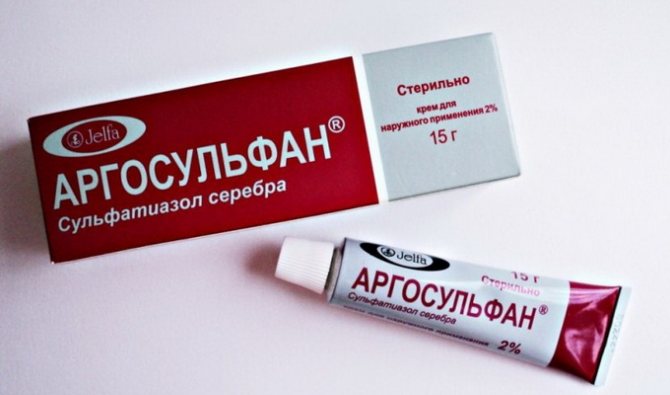
Price – 70–170 rubles.
Contraindicated in case of hypersensitivity to ichthyol. More than one generation has used it to treat wounds of pregnant women. But no special clinical trials have been conducted for pregnant women.
For advanced psoriasis, when the localization of the rash occupies a huge area, ointments containing steroids are used.
It consists of a component of the same name, which belongs to the group of steroidal anti-inflammatory drugs. Has the following effects:
- anti-inflammatory;
- antiallergic;
- hyposensitive.
The drug reduces severe itching, suppresses cellular immunity, and reduces the sensitivity of the skin to irritants. The ointment is used once a day. The course of treatment is up to 10 days.
The use of hydrocortisone ointment, due to its rapid onset of positive effects, daily and repeatedly, can lead to the development of severe side effects.
This is due to the fact that glucocorticoids affect all types of metabolic metabolism - carbohydrate, fat and protein. They also regulate the amount of ionic components - Na, K, Ca.
Side effects are atrophy of the mucous membranes and skin, swelling, itching, systemic manifestations in the form of hypertension, eczema, etc. The drug is also used in ophthalmological practice for the treatment of conjunctivitis, blepharitis and other inflammations of the eye appendages.
Price – from 40 rubles.
Also refers to glucocorticosteroids. Used for the treatment of large ulcerative skin defects and the development of purulent-inflammatory processes in them. The drug quickly fights inflammation, prevents the formation of pus in the formed wound, and reduces vascular permeability. Also has an antihistamine effect.
The anti-inflammatory effect is provided by the salicylic ointment included in the composition. It also has a softening effect and is recommended for use by people with rough, inelastic skin.
Betamethasone is prescribed for extensive psoriasis, lichen, erythroderma, photodermatitis and other skin pathologies. The ointment should be applied to moistened skin every 12 hours. When symptoms disappear, apply once.
The product must not be used for viral pathologies, tuberculosis, acne, diabetes, varicose veins.

The development of side effects is associated with repeated use of the drug more than 3 times a day.
Can appear:
- swelling;
- hyperglycemia;
- hypertensive crisis;
- neuroses;
- excess body weight;
- stretch marks;
- ovarian disturbance of the menstrual cycle in women.
Cost – from 115 rubles.
Infectious and inflammatory pathologies are caused by opportunistic or pathogenic flora entering small wounds.
We invite you to familiarize yourself with Ultrasound for professional facial cleansing
From the external environment or chronic foci of inflammation, which are localized in carious teeth, inflamed tonsils, etc., gram-positive and gram-negative bacteria can provoke the formation of wound defects, various papules, pustules, and erythema.
Treatment of diseases depends on the type of pathogen.
Resorcinol
Resorcinol ointment is formed by the main component resorcinol. Resorcinol is a white crystalline powder that, when combined with petroleum jelly, forms a liniment or ointment.
Resorcinol ointment has a local analgesic effect and also has an antimicrobial effect. The drug is used to treat eczema, fungal pathologies, itching syndrome, and seborrhea.
A special feature of the drug is its use at any age.
Price – from 400 rubles.
Wilkinson ointment
The composition includes tar, sulfur, calcium salts, naphthalan ointment and other components.
The ointment has antiseptic properties, antifungal and antiparasitic effects.
Apply twice a day, applying to inflamed areas. The course of therapy is 7–12 days. Sometimes the course of treatment is increased to 3 weeks.
The drug is also used in hospital inpatient departments when scabies is detected in patients. Wilkinson's ointment is applied to all areas of the body, except the facial area and scalp.
Cost – from 35 rubles.
Important! The drug is not prescribed for acute eczema. The ointment must be stored in the refrigerator.
Sangviritrin
It consists of the alkaloids sanguinarine and chelethrine, which come from the maclea plant. The drug is classified as an antimicrobial and antifungal drug. It has an anticholinesterase effect, through which it enhances the transmission of nerve impulses through synapses and neuronal connections.
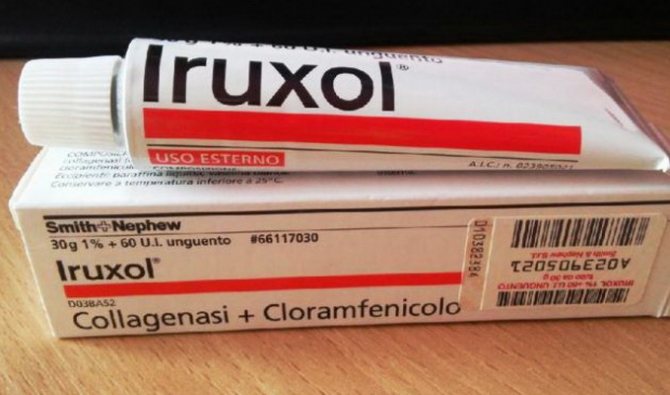
Sangviritrin is used to treat infectious inflammations of the skin - with purulent lesions, wounds, burns, and ulcerative defects that have not been cured for a long time.
The affected skin areas are treated first with a solution and then with liniment, applying a bandage. The procedure must be carried out 2-3 times a day.
Sangviritrin is used in childhood and adulthood.
Price – from 170 rubles.
Important! The drug is contraindicated in bronchial asthma and epilepsy. May cause a burning sensation if hypersensitivity to the main components included in the composition.
Benzydamine
The composition includes benzydamine chloride, glycerin, flavoring, sodium bicarbonate. It is a non-steroidal anti-inflammatory drug.
Has an analgesic effect. When applied to the affected area of the skin, it eliminates pain, itching, swelling and redness.
In addition, if there was hyperthermia in the affected area, benzydamine reduces the temperature. (An increase in temperature in the wound area occurs during inflammation caused by putrefactive bacteria).
Cost – from 400 rubles.
Important! May cause local allergic reactions in the form of itching.
Burns are skin defects caused by high temperatures. Burns lead to the formation of blisters, which eventually burst. These blisters prevent the wound from healing quickly.
First and second degree burns in most cases are caused by exposure to boiling water, hot oil, or objects heated over a hot fire. They are treated at home with anti-burn ointments.
Panthenol
It has slight anti-inflammatory activity and has pronounced regenerative activity for the growth of granulation tissue.
Belongs to the B vitamins. Panthenol is prescribed for dermatitis, bedsores, purulent-inflammatory processes and diaper rash.
The ointment must be applied once a day. Contraindication is hypersensitivity to pantathenic acid. The drug can be used during pregnancy and childhood.
It should be used with caution in case of pathologies of the liver and kidneys.
Cost – from 80 rubles.
Rescuer
An ointment made from natural ingredients with regenerating properties. Prescribed for shallow wounds, burns, bruises, dermatitis, insect bites and acne.
Do not use the ointment together with antiseptics (hydrogen peroxide).
The components of the drug and hydrogen peroxide can enter into a chemical reaction and cause a burn to the skin.
The effect of the ointment disappears when using ointments that contain glucocorticosteroids.
Price – from 150 rubles.
Dioxidine
Has an antiseptic effect. Removes purulent contents from the wound, destroying all signs of inflammation.
Indications for use are:
- acne;
- boils;
- burns;
- panaritiums;
- cracks in the rectal mucosa.
Contraindicated in case of individual intolerance to dioxidine. Can be used by children, pregnant women and during lactation.
Cost – from 300 rubles.
Actovegin
A metabolic drug that prevents the development of oxygen deficiency. It improves neuroprotective activity and microcirculatory function.
Used to treat disorders caused by circulatory disorders. It is prescribed for burns and diabetes.
Price – from 120 rubles.
Solcoseryl
A drug that increases the proliferative ability of fibroblasts, which causes rapid synthesis of granulation tissue and the creation of primary tension of the wound. Solcoseryl also has an antihypoxic effect and antiexudative effect.
When you definitely need to see a doctor
In some cases, treating the damage yourself is not enough. Medical assistance is necessary if:
- blood spurts out from the wound;
- blood flows profusely and does not stop;
- the cut is in a visible place and a scar on it is undesirable;
- the hands are affected - important nerves and tendons are located here;
- there are symptoms of inflammation - redness around the cut, swelling, increased body temperature;
- the wound is deep - a suture is necessary;
- the wound is dirty, and the tetanus shot was given more than 5 years ago;
- animal feces or soil got into the wound;
- the wound does not heal for a long time;
- after being wounded, a person feels sick and vomits.
Healing ointment with antibiotic for wounds
In the postoperative period, for the treatment of sutures, it is also important to choose the right ointments for wound healing, which will maximize the rapid healing of the skin
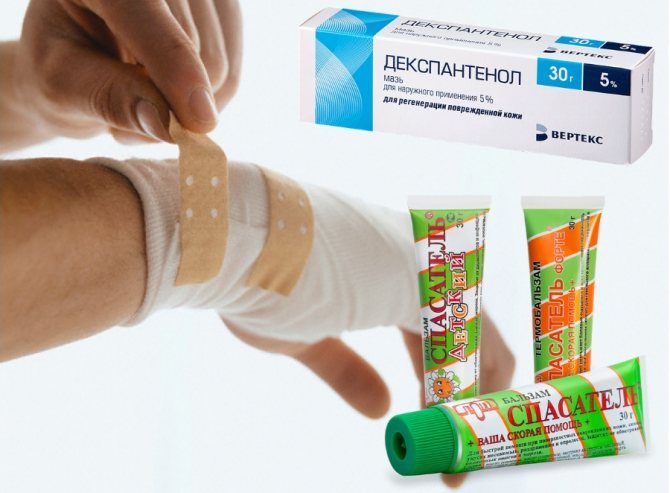
It also protects against suppuration and inflammation, which often occurs due to infection on the wound.
According to experts, after surgery it is better to use several ointments in combination. Since their action can complement each other, having a beneficial effect on the seams.
To treat seams, you can also use Solcoseryl, which we have already indicated above.
Actovegin
However, there is also its budget analogue - Actovegin, which also contains calf blood.
Actovegin is available in the form of a gel and ointment. And if the gel is recommended to be used to treat deep wounds, then the ointment is mainly used for wounds that are already healing.
One of the main disadvantages of this drug is that the drug is strictly prohibited for use during pregnancy and lactation.
In addition, before using the drug, you should consult a doctor, because the composition of Actovegin can provoke allergic reactions.
Levomekol
Probably one of the most popular remedies for the treatment of wounds and cuts is the antibiotic ointment Levomekol.
Which is quite often used both in the postoperative period and for treating purulent wounds. The ointment, thanks to the antibiotic contained in the composition, prevents suppuration.
Also, one of the advantages of Levomekol is its availability and budget. However, there are certain risk factors that need to be taken into account when using the ointment:
- With prolonged use of the ointment, excessive accumulation of the antibiotic on the skin and under the skin may occur, which can cause intoxication.
- Pregnant women are strictly prohibited from using the drug even in the most microscopic doses.
- The drug can cause allergies, skin rashes and even swelling of the skin, in which case treatment with Levomekol is strictly canceled.
Dermazin
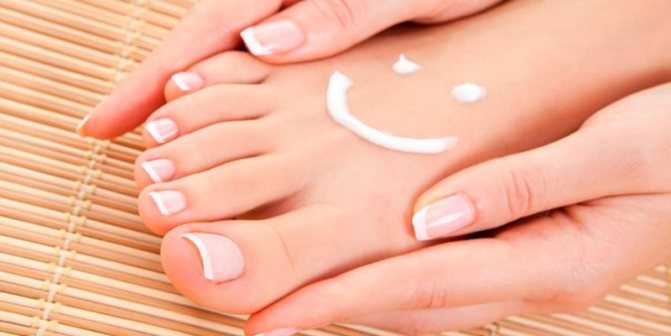
Popular remedies for the treatment of wounds and cuts include preparations that contain silver ions.
Thus, ointment with silver Dermazin perfectly dries and disinfects deep cuts and burns, thanks to the silver sulfadiazine included in the composition.
The effect of silver is as follows: its microparticles penetrate the DNA of dangerous bacteria and stop their growth and reproduction.
Side effects of Dermazin are associated with the possible appearance of itching and a decrease in the number of platelets in the blood.
Therefore, the use of this drug for children is contraindicated.
However, there is another silver-based product recommended for both adults and children.
Argosulfan
Argosulfan is recommended by leading pediatricians for children from two months and is completely safe.
The ointment has an analgesic and anti-inflammatory effect and does not contain contraindications.
To heal purulent wounds, antibacterial ointments with antibiotics (Levomekol), tightening ointments with iodine (Betadine), antiseptic ointments with silver (Argosulfan), and anti-inflammatory components (Spasatel) are used. For skin diseases, Sudocrem is used for a drying and healing effect; Baneocin relieves pain for purulent wounds. Their main characteristics are shown in the table.
| Action | Name | Indications | Who should not use it | How to use |
| Antibacterial with antibiotics for purulent wounds | Levomekol | Purulent wounds, ulcers, bedsores, boils | Psoriasis, eczema, fungal infection | From the first day, 3-4 days, on a napkin or directly on the wound |
| Antiseptic with silver | Argosulfan | Purulent wounds, abrasions, burns, ulcers, bedsores | Allergy to components | After cleaning the wound, open it until complete healing |
| Additive with iodine | Betadine | Minor cuts, abrasions, small incision after surgery, ulcers, bedsores | Iodine intolerance, hyperthyroidism, renal failure | Apply a thin layer 1-2 times a day for no more than 10 days after cleaning and drying |
| Anti-inflammatory | Balm Rescuer | Superficial and deep wounds, injuries, bruises, cracks, diaper rash, burns | Chronic ulcers, allergies to components | Wash and dry the wound, apply balm, cover with a bandage |
| Drying and healing for skin diseases | Sudocrem | Dermatitis, diaper rash, eczema, acne | Acute purulent process | Up to 5 times a day per lesion |
| Pain relieving ointments for wounds | Baneocin | Herpes, chickenpox, varicose ulcers, dermatitis, eczema, fissures, wounds after surgery | Extensive damage (risk of hearing loss and kidney function) | Apply to a wound, ulcer or gauze 2-3 times a day for no more than a week |
Ointments with antibacterial action
Levosin
Consists of Levomycetin, Methyluracil, Trimecaine and other auxiliary elements. Pharmacological action consists of antibacterial, anti-inflammatory and analgesic effects.
We invite you to familiarize yourself with Facial washes: rating of the 9 best products for different skin types
The drug is injected into pustular wounds and purulent cavities using sterile napkins soaked in ointment. The ointment can also be administered using a drainage unit only in the surgical department.
Prescribed only in the first period of a purulent wound process. Price - from 120 rubles.
Levomekol
Ointment with antimicrobial effect. Easily penetrates into destroyed epithelial tissues, stimulating regeneration processes.
Prescribed for the treatment of purulent wounds caused by gram-positive and gram-negative microflora.
Contraindicated in case of hypersensitivity to the main component - chloramphenicol or methyluracil.
Price – 100–250 rubles.
Ointment with antimicrobial action, which is prescribed:
- for acne;
- with pyoderma caused by streptococcus;
- with inflammation of the hair follicles;
- for eczema;
- with ulcers of trophic origin;
- after amputation of a limb as an antibacterial drug.
Apply to the wound 1-2 times a day, applying an aseptic bandage. The course of treatment is 10–21 days.
Cost – from 20 rubles.
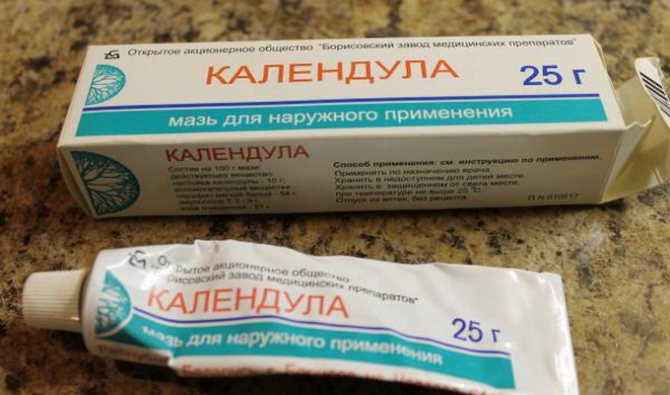
Important! Side effects include itching, redness and swelling in the area of application.
They are used to treat not only acne, but also bedsores, burns and infected wounds.
Has antimicrobial and bactericidal effects. Suppresses the proliferation of pathogenic microflora, preventing the progression of the inflammatory process.
The ointment is applied to the affected area only after it has been thoroughly treated with an antiseptic (furatsilin solution). The duration of treatment can vary up to 3 months.
Price – from 30 rubles.
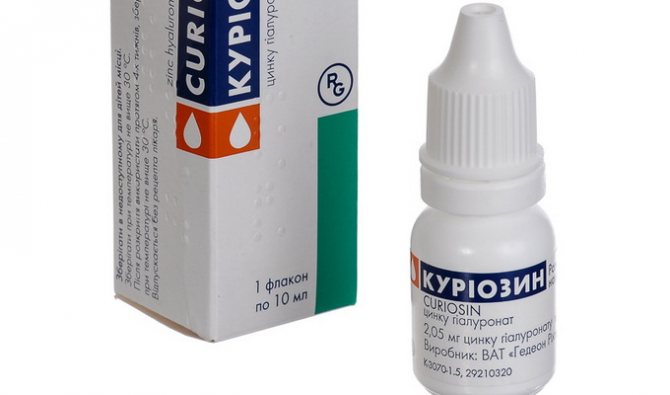
Important! Contraindicated during pregnancy.
Advantages and disadvantages
Like any medicine, ointments have pros and cons in use.
| Advantages | Flaws |
| availability of purchase - there are many inexpensive drugs (up to 100 rubles, 40 hryvnia) | contraindications - not everyone is suitable for purulent wounds |
| no prescription needed, in mild cases you can treat the wound yourself | individual intolerance to components - allergies and increased inflammation, itching, irritation, rashes |
| variety of components | |
| ease of use | when applied, they form a film under which microbes multiply |
| relieve inflammation | |
| destroy germs (if the composition contains an antibiotic or antiseptic) | there is a risk of suppuration and spread of infection, especially with self-medication |
| soften the skin | |
| stimulate cell division for rapid healing | should be prescribed by a doctor if there is an increase in body temperature, a twitching sensation in the wound, diabetes mellitus, low immunity, poor circulation |
The best ointments for wounds on the mucous membrane
The mouth, nose and eyes need constant attention to avoid the entry of harmful bacteria.
Of course, we don’t always succeed in this and sometimes the infection wins, but if you use special ointments, many problems can be avoided.
For reference! For the human body, the mucous membranes are extremely vulnerable to all kinds of infections and damage upon contact with the external environment.
A completely ordinary runny nose can lead to serious health problems.
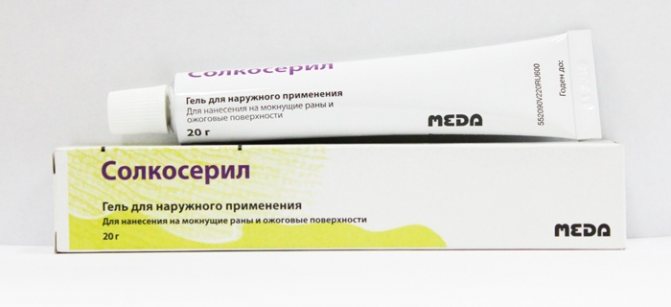
Therefore, most mothers know the best ointment that protects against attacks of viral infections and, of course, recommend it for use not only for children, but also for adults.
We are talking about Oksolin, which is applied inside the nasal passages several times a day.
After all, its use is completely safe and the only drawback can be that it is sold out extremely quickly in pharmacies during the cold season.
Antibiotic ointments: indications for use
Indications for use include not only open wounds, but also other lesions:
- pustules on the skin;
- microbial eczema;
- burns;
- psoriasis;
- bedsores and trophic ulcers;
- pyoderma – damage by streptococci and staphylococci;
- insect bites;
- itching;
- use for disinfection purposes.
You can call Eplan a universal remedy. It is suitable for almost all skin lesions, especially when there is a risk of infection of the wound with bacteria. The use of liniment is possible without consulting a doctor, but if the lesion is extensive, you should not rely on the drug, you should consult a specialist.
Recommendations for home treatment
Another common disease is herpes. Which appears on the lips due to weakened immunity, as a result of taking antibiotics, or even from hypothermia.
For this problem, it is important to choose the right remedy. After all, if it gets on the lips, the ointment can get into the mouth, and if the product is used without a doctor’s prescription, poisoning can occur.
Viferon is a safe product to use. Which, having a bactericidal effect, also stimulates the immune system.
A positive aspect of treatment with this remedy is that it has no side effects and can be used even by newborns.
Nystatin ointment is also recommended for the treatment of the oral cavity.
Using this ointment for stomatitis.
Firstly, it is accessible, since the ointment is relatively inexpensive.
Secondly, it is suitable for the treatment of wounds in the mouth because the substances included in its composition cope well with pathogens in a short time (from 2 to 5 days), penetrating the cells of harmful bacteria.
However, when using nystatin ointment, you should remember that you need to carefully follow the dosage. Using only a very small amount to apply to the wound with a cotton swab.
Otherwise, an overdose of the drug may occur.
When making such home therapeutic dressings, you should pay attention to such criteria as the size of the wound and its depth; as it heals, it should slowly decrease in size.
You should pay attention to changes in the amount of discharge from the wound, as well as its smell and necessarily color; it should not deepen or increase. Also here you should check your sensations, the pain should gradually go away, and the treatment should give a slow and sure result.
Changes in temperature, general chills and lack of results, redness of the skin and swelling are reasons to consult a doctor for advice.
How to choose wound healing drugs
When choosing a wound healing cream or ointment, it is important to consider the stage of the skin restoration process:
- At the first stage of healing, it is best to use a less dense form - gel, liniment or cream. They help provide air access and dry.
- The ointment is good to use after primary healing, when the discharge becomes insignificant. It creates a film that protects delicate granulation (new) tissue from damage and stimulates cell division.
Stages of wound healing
Healing is the revival of tissue through reparative processes aimed at ensuring the anatomical integrity of the damaged area.
Each healing goes through several stages:
- initial, inflammatory in nature with temporary closure (coagulation) and cleansing of the wound;
- intermediate, in which granulation tissue forms on the wound surface;
- the last phase of maturation (much longer) with scar modeling.
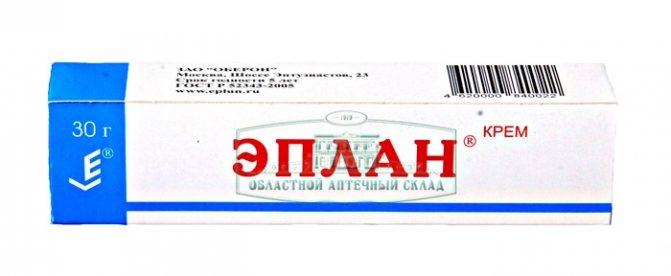
A review of wound healing products reveals their functions:
- Disinfectants. The drugs disinfect and create protection against infection of the body. Effective on cracks, scratches, abrasions and cuts.
- Antibiotic creams. Designed for purulent wounds, postoperative sutures, bleeding cracks, ulcers, erosions and burns.
- Regenerating. Accelerate the healing of open wounds, trophic ulcers, abrasions, frostbite.
- Drying. Suitable for weeping wounds, wounds in the mouth, purulent cracks in the skin of the hands and feet.
Criterias of choice:
- doctor's recommendations;
- presence of contraindications;
- individual intolerance to active substances;
- wound condition and healing stage;
- product type: gel, powder, spray, creams, ointments, patches or dressings;
- composition of the drug;
- best before date;
- integrity and convenience of packaging;
- storage conditions;
- price.
If the wound is weeping, then if there is copious discharge, wound healing ointments should not be used. After treatment with a solution of Chlorhexidine or Miramistin, enzymes (Chymotrypsin, Trypsin) and Baneocin powder are used. After the wound begins to be covered with new tissue (granulation), external agents with complex action are prescribed - Gioksizon, Vulnuzan, Sulfargin.
Hyoxysone
Due to the content of hydrocortisone, it has a local anti-inflammatory effect, and the antibiotic oxytetracycline inhibits the growth of microbes. Not used for viral skin lesions and fungal infections. Apply to a sterile gauze pad for dressings for no more than 10 days. Contraindicated in children and pregnancy.
Hyoxysone
Price – from 75 rub.
Vulnuzan
The drug contains microelements in high concentrations, they are:
- help dry the wound;
- have an anti-inflammatory effect;
- increase local immunity;
- stimulate healing and complete restoration of the skin.
Vulnuzan is used for wounds:
- with suppuration;
- surgical;
- ulcers;
- ulcers due to injury or vascular insufficiency;
- cracked nipples.
Vulnuzan Apply either directly to the damaged area or to a sterile napkin once a day. Contraindicated in case of intolerance to the components and for treatment during pregnancy, children under 12 years of age.
Price – from 170 rub.
Sulfargin
The ointment has an antimicrobial effect due to sulfonamide and silver ions. It dries the wound surface and is used to treat burns, abrasions, wounds with signs of suppuration, as well as to prevent the development of infection. Not indicated for deep injuries, prohibited for children under 1 year of age and pregnant women. Apply openly or under a bandage 1-2 times a day.
Sulfargin
Price – from 250 to 320 rubles.
You may be surprised, but our grandmothers and great-grandmothers, unable to purchase ointments for wound healing at the pharmacy, made the ointment themselves.
The basis for it was lard, which was heated in a water bath and then various compositions of herbs, berries, honey or beeswax were added to it.
For example, for tumors and redness, as well as for bruises, the following ointment was prepared:
- 100 grams of lard
- 100 grams of butter
- a tablespoon of honey
- a tablespoon of string and celandine
- mix and place in a water bath.
The ointment will be ready in half an hour, it is filtered, cooled and it is completely ready for use.
The only drawback of this ointment is that the product is stored for a very short time, due to the natural ingredients it contains.
The best ointment for wound healing - a review of popular drugs
The most effective drugs in pharmacology are multicomponent ointments that disinfect and quickly heal damaged skin areas.
Among the proven, reliable and effective means, we can highlight the “golden ten” - these are the ointments that you should definitely know about and use if necessary.
Levomekol
Antibiotic ointment for wound healing should be in every first aid kit. It is indispensable for purulent abscesses, burns, ulcers, and bedsores. Active ingredients: chloramphenicol, as well as a substance that stimulates the immune system - methyluracil, which promotes rapid healing of the epidermis.

The product is applied in a thin layer to the damaged area twice a day, but treatment should not last more than ten days.
Advantages:
- protects wounds from infection;
- relieves inflammation;
- has a wide spectrum of action;
- destroys all types of gram-positive bacteria;
- can be used by children and expectant mothers.
Flaws:
- with frequent use, addiction occurs and efficiency decreases;
- local reactions are possible in case of individual intolerance to one of the components.
Price – 95 rubles, tube 45 g.
Solcoseryl
Regenerating cream activates metabolism in the skin and promotes rapid healing. Made from dialysate from the blood of dairy calves.
Increases the supply of oxygen to cells, normalizes metabolism, accelerates regeneration. Indicated for minor injuries, first and second degree burns, frostbite, poorly healing wounds, ulcers, erosion.
Advantages:
- absolutely safe for children;
- activates the transport of oxygen and glucose to damaged cells;
- can be used for cosmetic purposes, in particular against wrinkles in the eye area.
Flaws:
- high price;
- may cause urticaria, dermatitis;
- does not contain antimicrobial components;
- Use when carrying a child only as prescribed by a doctor.
Price – 505 rubles, 20 g.
Actovegin
This ointment is a tissue regeneration stimulator. The active component is deproteinized blood of dairy calves, which affects cells at the molecular level and significantly accelerates healing. Due to the fact that the composition contains biological components, the drug is absolutely safe for children.
Used to heal the acute stage of burns of any etiology - solar, chemical, radiation. Effectively treats weeping ulcers, bedsores, cracks, abrasions and cuts.
Advantages:
- helps speed up metabolism;
- reduces tissue hypoxia;
- stimulates healing;
- can be used during pregnancy;
- suitable for children;
- the effect occurs within half an hour after application.
Flaws:
- may cause a local hypersensitivity reaction.
Price – 110 rubles, 20 g.
Methyluracil
An excellent drug that stimulates rapid healing of the skin. Its main purpose is to normalize nucleic acid metabolism and accelerate cell regeneration.
Prescribed for deep and poorly healing wounds, bedsores, trophic ulcers, burns, dermatitis, cracks, abscesses, furunculosis. It removes traces of acne well and smoothes out scars.
Advantages:
- improves tissue trophism;
- stimulates regeneration;
- “boosts” the immune system;
- reduces the inflammatory process;
- The ointment is compatible with antibiotics, antiseptics, and sulfonamides.
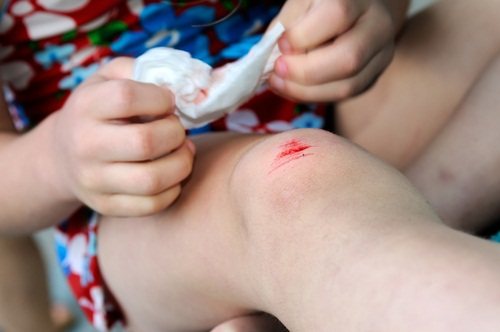
Flaws:
- may cause tingling, irritation, itching.
Price – 35 rubles, 25 g.
Vishnevsky ointment
An antibacterial agent known for more than one generation. It was invented back in the late twenties of the last century by military surgeon Alexander Vishnevsky for the treatment of shallow purulent wounds and is still relevant today.
The ointment uses time-tested ingredients.
- Birch bark tar. It has antimicrobial and antiseptic properties and has long been used by our ancestors to treat inflammation, purulent lesions, gangrene, psoriasis and other diseases.
- Castor oil. It is obtained from castor bean seeds by cold pressing. Effective for treating various skin rashes, frostbite, burns. Has a destructive effect on bacteria and fungi. Has excellent regenerating properties.
- Xenoform. A synthetic antiseptic that has an oxidative effect on the cellular structure of the infectious pathogen.
The ointment is used already at the healing stages, when the wound does not bleed and does not secrete substrate. The antiseptic effects are weak, so it will not be able to stop deep inflammatory processes. It is usually prescribed for minor burns and frostbite, purulent formations on the skin, restoration of the epidermis during bedsores, and for the treatment of acne (pimples).
Advantages:
- relieves inflammation in the subcutaneous tissue;
- prevents tissue swelling;
- softens and dries;
- stimulates nerve endings;
- increases regeneration of skin and mucous membranes;
- accelerates the maturation and breakthrough of purulent foci.
Flaws:
- specific smell of tar;
- weak antiseptic;
- not suitable for deep wounds.
Price – 45 rubles, tube 30 g.
This product has been sold in pharmacies since the middle of the last century and is still popular. It is inexpensive, accessible, time-tested and very effective.
The ointment is based on ordinary medical petroleum jelly and ichthammol, which is a black resinous substance with a rather pungent odor. The high sulfur content in its composition has the same well-proven therapeutic effect. It literally destroys the protein and cellular structure of the infectious agent.
The ointment accelerates the regeneration of damaged skin and promotes rapid healing. It is successfully used for eczema, furunculosis, erysipelas, and psoriasis. It is enough to apply a thin layer to the damaged area once or twice a day, and apply a bandage if necessary.
Advantages:
- relieves pain;
- disinfects;
- stops inflammation;
- has an antiseptic effect;
- increases blood microcirculation in affected areas;
- prevents suppuration;
- softens the infiltrate and promotes its removal;
- dries out the wound.
Flaws:
- has an unpleasant odor;
- allergic skin reactions with individual intolerance;
- cannot be used by children under 12 years of age.
Price – 75 rubles.
Burn healing cream is one of the best for open wounds. It has a very strong analgesic effect. It is also used to treat bruises, cuts, frostbite, purulent lesions, and cracks.
The universal product is so multifunctional and effective that it still has no analogues not only in our country, but throughout the world.
Advantages:
- effective antiseptic;
- strong pain reliever;
- does not contain hormones, antibiotics and analgesics;
- if necessary, the course of treatment can reach one month;
- has bactericidal and regenerating properties;
- The ointment is non-toxic and has no contraindications.
Flaws:
- may cause allergies if any ingredient is intolerant.
Price – 190 rubles, 30 g.
D-Panthenol
It has an anti-inflammatory and wound-healing effect, stimulates tissue repair. Used to treat deep wounds after abdominal operations, as well as for household injuries - cuts, abrasions, scratching, insect bites.
Indispensable for young mothers - it quickly and effectively tightens cracks in the nipples, and relieves babies from diaper dermatitis and diaper rash.
Advantages:
- accelerates healing;
- relieves inflammation and swelling;
- provides a powerful antiseptic effect;
- destroys germs and bacteria;
- creates protection against infection.
Flaws:
- allergic reactions;
- cannot be used on weeping wounds.
Price – 155 rubles, 25 g.
Baneocin
Healing ointment is a combined antibiotic and is effective for infected skin lesions, wounds and skin diseases.
Advantages:
- has an anti-inflammatory effect;
- antibacterial agent;
- successfully treats any purulent lesions;
- suitable for children.
Flaws:
- not compatible with some medications;
- a large list of contraindications.
Price – 165 rubles, 20 g.
Argosulfan
The antibacterial drug with silver sulfathiazole is an excellent disinfectant. It is prescribed for minor cuts and abrasions, to prepare skin for grafting, as well as for the treatment of shallow purulent wounds, burns, and bedsores.
Advantages:
- prevents the spread of infection;
- eliminates pain and burning;
- reduces regeneration time.
Flaws:
- It is not recommended to use together with other similar agents, so as not to weaken the antimicrobial effect;
- not prescribed for infants under 2 months due to the risk of nuclear jaundice;
- local reactions are possible - itching, tingling, hyperemia.
Price – 320 rubles, 15 g.
Using Lokoid ointment
Lokoid is a hormonal-based drug. Its main task is the treatment of superficial non-infected skin diseases. It has shown the greatest effectiveness in the treatment of eczema, dermatitis, and psoriasis.
Most people who have used the product note that Lokoid quickly relieves itching, reduces swelling, and helps eliminate the inflammatory process on the skin.
The drug should not be applied to skin where there are open wounds or scratches.
The drug is available in the form of ointment and cream and is intended for use in children after 6 months. It has been praised for its effective itching relief, anti-inflammatory and antiseptic properties.
The cream is prescribed only for damage to the upper layers of the skin; it does not have a serious cumulative effect and does not work if the infection spreads to the deeper layers of the skin.
The drug is not suitable for the treatment of open skin lesions. It is indicated for psoriasis, dermatitis, lichen, seborrhea.
"Eplan"
The product does not contain antibiotics and hormones in its composition, like other wound healing ointments. For open wounds, this is an excellent antiseptic and analgesic medication. It is approved for use in the treatment of frostbite, burns, cracked fingers, bruises, cuts, etc. The main active ingredient of the ointment is glycolan.
According to the instructions, the product should be applied to the skin in a thin layer or in applications. Purulent wounds should be carefully cleaned before applying the drug. To treat cracks, the product can be used daily, in severe cases, applying it to gauze and applying it to the damaged area.
A significant advantage is the absence of hormones in the composition of the drug. "Eplan" (ointment for healing wounds and cracks) can be used for a long time. If necessary, the course of treatment can be more than 4 weeks. Contraindications include only individual intolerance to individual components of the drug.
The drug is available in the form of liniment and cream. It increases regeneration processes and also has an antiseptic effect. It is based on glycolan, water, ethyl carbitol, triethylene glycol and glycerin, which provide the properties of liniment and give it the necessary consistency. This healing ointment for open wounds is effectively used in surgery.
The drug is used only for topical use, and its effect begins immediately after application to the desired area. The therapeutic effect lasts for a long time - 6-8 hours, after which it is necessary to reapply the cream or liniment.
The ointment is used on the wound for healing for a long time - until the skin condition is completely restored. Before application, the surface of the wound should be cleaned, removing exudate.
The cream or liniment is applied in a generous layer. If the drug is used to treat acne, it is applied at night in a thin layer to cleansed, dry skin.
Liniment can be used as a protective agent. It is applied to the skin before going out into the cold or in contact with chemicals.
For disinfection, it is applied to the skin of the face and hands several times a day. This is advisable when the sanitary and epidemiological situation worsens.
Experts often prescribe Eplan. Its price is 80-120 rubles.
Universal healing ointment without scars. Has powerful disinfecting properties. The drug is a widely used drug. Eplan promotes rapid healing of even deep cuts, provides excellent pain relief, and relieves redness and swelling. The ointment is used to treat the following injuries:
- minor and deep damage to the dermis;
- all types of burns;
- frostbite of all degrees;
- herpes;
- eczema;
- inflammatory processes of the skin;
- abrasions, cuts, scratches.
Important! The ointment not only perfectly heals and disinfects. Eplan effectively fights certain types of fungal infections and other pathogens.
The release forms of the drug are as follows:
- Cream.
- Solution.
- Wipes (gauze and sterile) with an antiseptic effect.
Eplan in the form of napkins is perfect for providing first aid for skin injuries. The medicine in the form of an ointment is used to treat wounds several days after receiving them. The ointment eliminates inflammation, promotes healing, and actively fights germs and viruses. Apply the product to damaged areas 2-3 times throughout the day. The cost ranges from 150-180 rubles.
MORE ABOUT: Ointment for leg joints
Rating of the best cheap
In the price category of drugs up to 100 rubles (40 hryvnia), you can choose the following wound-healing ointments (in descending order of activity): Levosin, Dexpanthenol, Calendula.
Levosin
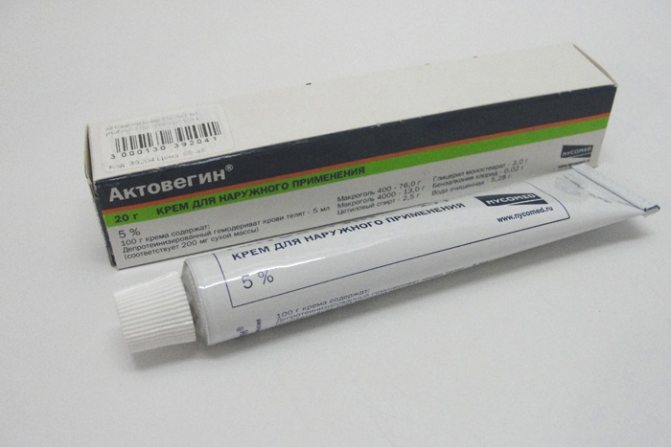
This is a combined external agent that has the following actions:
- antimicrobial (antibiotic chloramphenicol);
- anti-inflammatory (sulfonamide sulfadimethoxine);
- wound healing (methyluracil);
- painkiller (trimecaine).
An important feature is the water-soluble base, which helps to carry the components into the deeper layers of the skin and does not prevent the surface from drying out. Levosin has a high concentration, due to this the swelling of the surrounding tissues is reduced and the wounds are cleansed of pus and dead cells quickly (in 2-3 days).
Indicated for treatment in the first days after injury, used for purulent wounds and difficult-to-heal injuries. Levosin is impregnated with a sterile gauze pad and applied to the wound skin defect.
Contraindicated in case of individual intolerance to the components; it is prescribed with caution (in small areas, no more than 2 days) during pregnancy and breastfeeding.
Price – 70 rubles, 40 hryvnia.
Levosin
These relatively cheap ointments have an active ingredient - dexpanthenol, which has vitamin activity and accelerates the restoration of not only the skin, but also the mucous membranes. A great advantage is its very low toxicity, which allows the ointment to be used for children, pregnant and lactating women with:
- minor burns, including sunburns;
- abrasions;
- bedsores;
- difficult-to-heal chronic ulcers;
- dryness and flaking of the skin, cracks;
- care for babies, mammary glands;
- restoration of the skin after treatment with potent external drugs;
- after cosmetic procedures and operations.
Dexpanthenol Hepiderm Ointment is applied in a thin layer 1-3 times a day. When used, allergic reactions rarely occur, but with increased sensitivity to the drug, rashes, itching, blisters, and redness are possible. Not recommended for use on weeping wounds.
On average, the price fluctuates between 70-80 rubles, 40 hryvnia.
Calendula ointment
Ointment with calendula tincture has an active anti-inflammatory and wound-healing effect; its antibacterial, analgesic and antipruritic effects are slightly less pronounced. Recommended for minor injuries (cuts, bruises, abrasions, burns), as well as for caring for the skin of the mammary glands and perianal area (prevents and treats cracks).
The ointment is applied to the skin; a sterile gauze bandage can be applied over it or the surface can be left open. The course of treatment is from 7 to 20 days. An allergic reaction to the drug is possible.
Calendula ointment
The ointment has the cheapest price among analogues - 20 rubles, 9 hryvnia.
Top 10 drugs from the pharmacy
A high-quality ointment for wound healing restores the skin and does not provoke the development of complications. It treats inflammation, eliminates pain and swelling. And the presence of antimicrobial components in the ointment allows you not to fear bacterial infections.
Levomekol
Levomekol is a combination drug that contains an antibiotic and methyluracil (an immunomodulatory agent). The latter substance is involved in the metabolism of nucleic acids, affects the regeneration process and acts as an anti-inflammatory drug.
Indications:
- trophic ulcers;
- purulent wounds;
- burns;
- boils.
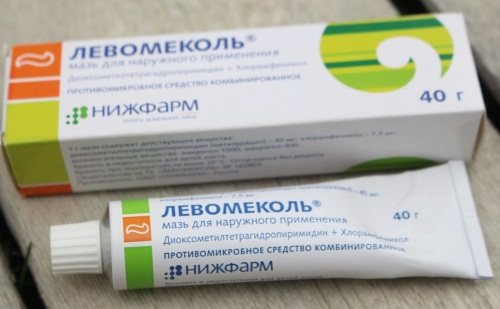
The product should be applied to a sterile cotton swab and applied to the wound. To clean the wound, the tampon must be changed every day. It is allowed to introduce the ointment into the purulent cavity using a syringe after heating to a temperature of +35°C. The product should not be used by people who have an allergic reaction to the substances of the drug. The medicine is produced in metal tubes, sold freely, price from 35 rubles.
Eplan
Ointment for healing wounds on the face Eplan is a medicinal product that is used in dermatology and cosmetology. The ointment is universal and is used for any skin lesions.
Eplan is the safest drug.
The medicine is produced in aluminum tubes with a screw cap. The active component of the product is glycolan and several additional ones: triethylene glycol, glycerin, ethyl carbitol. Each of these substances has beneficial properties. Eplan is also produced in other forms: liniment with urea, napkins, pencil.
Indications:
- hemangioma;
- cracks;
- dyshidrosis;
- deep ulcers;
- microbial eczema.
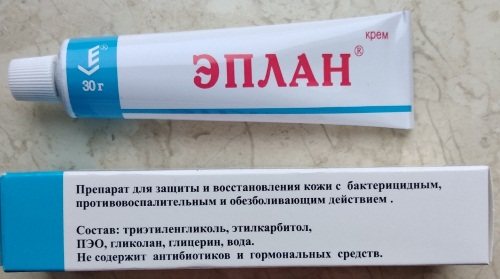
Contraindications to the drug include allergies to the components of the drug. The drug is used a couple of times a day. The duration of therapy is determined by a specialist. Eplan prevents skin damage from chemicals. The medicine can be bought freely, the price starts from 190 rubles.
Nitacid
Nitacid is an effective drug for treating rotting wounds. Its active ingredients are streptocide and nitazol. Additional components: proxanol, polyethylene oxide, propylene glycol. The product is produced in aluminum tubes of 15 g.
The cost of the drug is from 220 rubles. Nitacid is an antiseptic drug with an antimicrobial effect. It is effective against gram-negative and gram-positive bacteria. Nitacid relieves inflammation and, thanks to its composition, dries out the damaged surface of the skin. The ointment penetrates deep into the layers of the epidermis and prevents the development of infection.
Indications:
- infected wounds;
- fistulas;
- bedsores;
- inflammatory skin diseases;
- burns.
To increase the effectiveness of the medication, the damaged surface is first cleaned of purulent-nicrotic masses. A small amount of medication should be applied to the skin and the wound should be covered with a sterile bandage. For purulent wounds, the product is applied once a day, for erosive and ulcerative pathologies, 1-2 times a day.
Contraindications:
- allergy to substances in the product;
- breastfeeding period;
- time of pregnancy.
The product can be bought without a prescription, price starts from 170 rubles.
Streptoplaven
Streptoplaven quickly relieves inflammation and stimulates the healing of soft tissues. The ointment has an increased ability to be absorbed due to its balanced composition and the presence of a water-soluble base. The medicine is produced in a metal tube contained in a cardboard package.
The duration of use and frequency depend on the current pathological process. The medicine must be applied in a thin layer to the wound without rubbing. For adults, the product should be applied 2-4 times a day. Its water-soluble base has high osmotic activity, which ensures rapid penetration of the product into the deep layers of tissue.
The active ingredient is miramistin, and additional ingredients are distilled water, ultralysine, and glycine. The price of the product is from 85 rubles. Treatment of deep wounds includes the use of special napkins, which are placed in the cleaned wound and changed once a day.
Indications:
- acute purulent skin diseases;
- post-operative period;
- abscess;
- trophic ulcers.
Contraindications to the drug include: allergies to substances in the drug.
Rescuer
Rescuer ointment is a medicinal medicine for healing wounds on the face, which has a bacteriostatic effect. The ointment is produced in tubes of 10 and 15 mg.
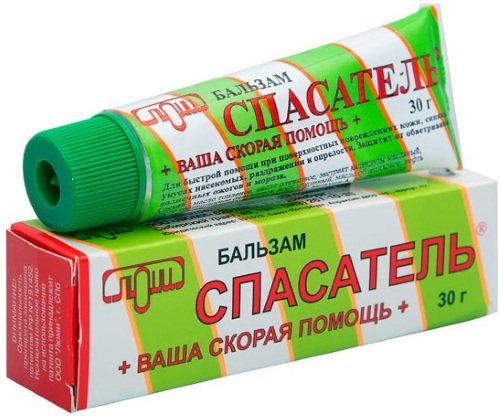
The drug includes:
- calendula;
- sea buckthorn;
- vitamin E and A;
- wax;
- melted butter.
The medication does not contain flavorings, dyes of any kind, as well as antibiotics and hormonal substances. The ointment restores skin protection and healing processes. After using the ointment, the process of tissue regeneration occurs much faster.
Indications:
- minor cuts and wounds;
- bruises;
- sprain.
Contraindication:
- chronic wounds;
- allergy to medication substances.
The medication should be applied directly to the skin lesion. After application, the medicine should be rubbed into the skin with massage movements. The duration of therapy is determined by a specialist. The medicine can be purchased freely, the price starts from 170 rubles.
D-panthenol
D-panthenol is a dermatotropic, vitamin and regenerating agent. The medication is produced in the form of ointments and creams in aluminum tubes of 10 and 15 mg. The cost of the drug is from 215 rubles. D-panthenol is also produced in the form of a spray and emulsion ranging from 150 to 250 rubles.
The ointment includes:
- dexpanthenol;
- ketomacrogol;
- demitecon;
- propylene glycol.
The ointment relieves inflammation, stabilizes lipid metabolism, and has a positive effect on intestinal motility.
Indications:
- burns of varying severity;
- minor skin damage;
- bedsores;
- furunculosis.
Contraindications:
- allergy to substances in the product;
- lung diseases;
- bronchial asthma;
- weeping wounds.
The product is applied in a thin layer to damaged skin areas and rubbed in with light movements. The application area is treated with an antiseptic in advance.
The product has a long lasting effect, stays on the skin for a long time and is slowly absorbed. The number of applications of the drug is 2-4 times a day. The spray is sprayed from a short distance onto damaged areas of the skin for 10 days.
Bepanten
Bepanten ointment is an external remedy with a regenerating effect. The drug is produced in the form of cream and ointment of 10 and 15 mg in aluminum tubes.
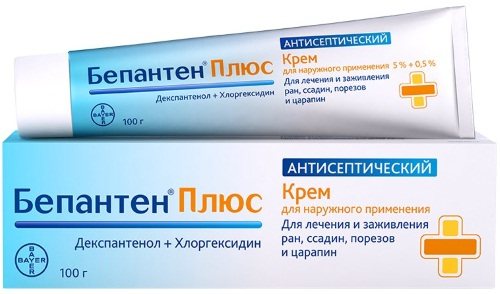
Bepanten - ointment for healing wounds on the face and body
Contraindications
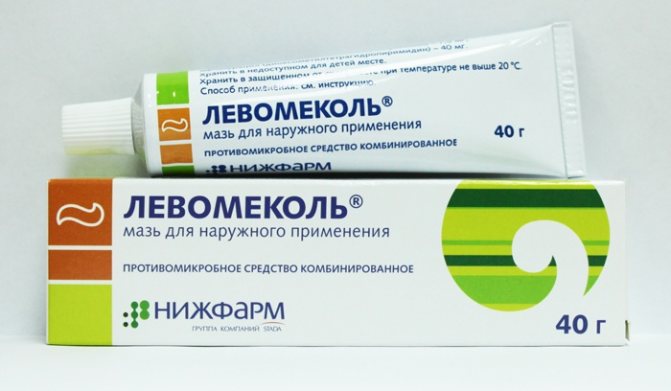
An absolute contraindication to the use of external agents is hypersensitivity to active or auxiliary ingredients. Some ointments are prohibited for use during pregnancy and lactation. Others cannot be used for severe endocrine disorders, liver and kidney pathologies.
The pharmacy assortment includes many gels, creams, balms, which are dietary supplements. This is the Healer, the Rescuer, the Guardian. Most dietary supplements are strictly prohibited for use in the treatment of children, pregnant and breastfeeding women. The manufacturer has not provided data on the safety of the products for these categories of patients. Many bioactive supplements are not intended for use on open wounds due to the presence of essential oils.
Be careful: there are contraindications
The best healing ointment for open wounds
For an open wound, healing ointments are used that have an anti-inflammatory and rapid reparative (restorative) effect: Eplan cream, Baneocin ointment, Solcoseryl gel.
Eplan cream
It is recommended to have this drug in your home medicine cabinet, as it is universal for household open wounds:
- a cut,
- attrition,
- abrasion,
- burn,
- frostbite,
- wound.
The drug has an antimicrobial and rapid anti-inflammatory effect, helps with sports injuries, bumps, and bruises.
When applied to a wound, it does not stick to the bandage, relieves swelling and itching from insect bites. It is safe for children, pregnant women and the elderly, and can even be used for pets. It treats skin rashes - acne, eczema, herpes, warts, fungi.
When treating hands and feet, it helps prevent microbial, viral, fungal infections, and irritation from household chemicals. Not recommended for use in cases of heavy bleeding.
Baneocin
Baneocin ointment is used to treat wounds:
- after surgery, opening of an abscess, panaritium (periungual suppuration), hidradenitis (clogging of the sweat gland);
- if infection is suspected on damaged skin (through contact with the ground, contaminated objects);
- due to injury, cut, burn;
- to enhance the regenerating (healing) effect of drugs for the treatment of trophic ulcers on the leg with varicose veins;
- after skin grafting;
- in plastic surgery.
Baneocin The drug contains two strong antibiotics - neomycin and bacitracin. When applied to a large area of the body, absorption into the blood and deterioration of hearing, kidney and liver function cannot be ruled out. If the damage is local, then Baneocin is well tolerated and rarely causes adverse reactions. The ointment is applied to the skin 2-3 times a day or used for dressings.
Price – from 180 to 340 rubles.
Solcoseryl gel
The drug accelerates wound healing by enhancing metabolic processes and oxygen absorption by cells. Indicated for wounds, cracks and cuts in the skin, burns, abrasions, long-lasting ulcers, bedsores. You need to lubricate the affected area at least 2 times a day for 10 days, and then you can switch to cream and ointment. Solcoseryl is well tolerated by most patients; an allergic reaction rarely occurs.
Price – from 410 to 1600 rubles.
Panthenol plus
Bepanten plus
Actovegin cream
Price – from 550 rub.
EPLAN: UNIVERSAL WOUND HEALING DRUG
Answer: Purulent-inflammatory processes of various etiologies and localizations occupy one of the leading places among all surgical patients. Treatment and care of wounds remains one of the important problems of modern medicine. Patients with wounds of various origins make up a significant proportion of patients in surgical hospitals. In recent years, many ideas about methods of wound healing and wound care have been revised, as well as previously used classifications of local treatments for wounds of various origins.
The reasons for the increase in the frequency and severity of purulent infection are diverse and include the following factors: an increase in the volume of surgical interventions, an expansion of methods of instrumental examination and treatment, accompanied by infection of the patient.
The introduction of antibiotics into medical practice has led to significant success in the treatment of purulent infections, reduced mortality in many pathological processes, and reduced the incidence of postoperative purulent complications. However, the process of formation of resistance of microorganisms has spread to almost all groups of drugs used for local treatment of purulent-inflammatory processes. Widely used fat-based ointments proposed for the treatment of wounds: Vishnevsky ointment, Sorcoseryl ointment and jelly, sea buckthorn oil, rosehip oil, etc. - all of these drugs do not contain an antimicrobial component, which does not allow treating wounds with these drugs in case of a high risk of wound infection . The active introduction into the practice of treating wounds of antiseptics or antimicrobial drugs, as well as polyethylene glycol-based ointments (levosin, levomekol, povidone-iodine, EPLAN) has significantly improved the results of treatment of patients with soft tissue infections.
The drug EPLAN (ointment and solution) simultaneously has an effective wound-healing, regenerating, and bacteriostatic effect.
When treating wounds (including purulent ones), the wound surfaces are treated daily with an antiseptic solution (hydrogen peroxide, miramistin, etc.), necrotic discharge is removed, after which the wounds are covered with gauze pads, generously soaked in Eplan. Dressings are performed once a day. EPLAN wound healing ointment is used to treat purulent wounds under bandages with copious amounts of wound discharge until the initial stage of the regenerative process and epithelization. Wound healing with EPLAN in the form of a solution is more effective in stimulating healing until active granulation growth is achieved.
The drug is well tolerated, there are no side effects immediately after applying the bandage and in the long term, and it prevents the appearance of itching of the skin in the wound area. During the first 3-4 days, wound discharge decreases, pain and swelling of the wound tissue and surrounding tissues decrease. The bandage does not stick to the wound surface. On days 5-7, the wound surface is covered with a thin layer of mature granulations, which indicates the need to switch to treatment under a bandage using EPLAN solution. During this period of treatment, active growth of the marginal epithelium is observed, and the area of the wound is clearly reduced. Treatment of wounds is completed by treatment with EPLAN solution, but without a bandage.
Precautionary measures
Before using any medicine, it is necessary to assess the severity of yourself or the victim.
- If wounds, abrasions, cuts, burns are minor, then treatment can be carried out at home.
- Before using the drugs, you must read the instructions. It is imperative to look at the composition of the ointment, indications, contraindications and side effects.
- The drug must be applied with sterile hands (use alcohol wipes or wash your hands thoroughly with an antiseptic). In addition, you should find out the expiration date.
If undesirable effects occur, stop using the drug.
Useful tips
Injuries can be different. Minor abrasions, burns and scratches can be treated at home without any problems, but more serious wounds require seeing a doctor.
What else do you need to know about wound healing ointments?
- Be sure to read the attached instructions, especially carefully read the indications, contraindications and adverse reactions.
- If allergic reactions or other undesirable effects occur, you should immediately stop using the drug.
- If a positive effect is not observed, you should consult a doctor.
- Treat sutures after surgery only with the ointments prescribed by the surgeon.
- Monitor the expiration date and store medications properly. Some ointments need to be kept in the refrigerator, otherwise they may lose their healing properties.
- If you suffer from diabetes, then ointments containing sulfonamides are contraindicated for you.
- In case of infection and purulent inflammation of the wound, it is recommended to consult a doctor, since complex treatment is already required here. To enhance the effect, along with ointments, the surgeon will prescribe anti-inflammatory or antibacterial tablets.
